Vascular remodeling is governed by a VEGFR3-dependent fluid shear stress set point
- PMID: 25643397
- PMCID: PMC4337723
- DOI: 10.7554/eLife.04645
Vascular remodeling is governed by a VEGFR3-dependent fluid shear stress set point
Abstract
Vascular remodeling under conditions of growth or exercise, or during recovery from arterial restriction or blockage is essential for health, but mechanisms are poorly understood. It has been proposed that endothelial cells have a preferred level of fluid shear stress, or 'set point', that determines remodeling. We show that human umbilical vein endothelial cells respond optimally within a range of fluid shear stress that approximate physiological shear. Lymphatic endothelial cells, which experience much lower flow in vivo, show similar effects but at lower value of shear stress. VEGFR3 levels, a component of a junctional mechanosensory complex, mediate these differences. Experiments in mice and zebrafish demonstrate that changing levels of VEGFR3/Flt4 modulates aortic lumen diameter consistent with flow-dependent remodeling. These data provide direct evidence for a fluid shear stress set point, identify a mechanism for varying the set point, and demonstrate its relevance to vessel remodeling in vivo.
Keywords: arteriogenesis; cell biology; homeostasis; human; human biology; mechanotransduction; medicine; mouse; shear stress; vascular remodeling; zebrafish.
Conflict of interest statement
The authors declare that no competing interests exist.
Figures
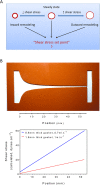

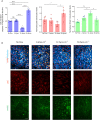
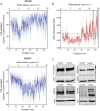
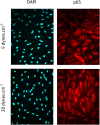
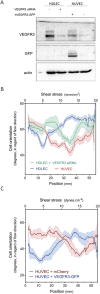





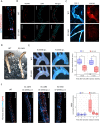
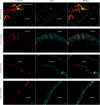
Similar articles
-
Intramembrane binding of VE-cadherin to VEGFR2 and VEGFR3 assembles the endothelial mechanosensory complex.J Cell Biol. 2015 Mar 30;208(7):975-86. doi: 10.1083/jcb.201408103. Epub 2015 Mar 23. J Cell Biol. 2015. PMID: 25800053 Free PMC article.
-
Fluid shear stress regulates vascular remodeling via VEGFR-3 activation, although independently of its ligand, VEGF-C, in the uterus during pregnancy.Int J Mol Med. 2017 Oct;40(4):1210-1216. doi: 10.3892/ijmm.2017.3108. Epub 2017 Aug 25. Int J Mol Med. 2017. PMID: 28849193 Free PMC article.
-
[Rheologic properties of the human umbilical vein endothelial cells exposed to shear stress].Hua Xi Yi Ke Da Xue Xue Bao. 1995 Jun;26(2):181-6. Hua Xi Yi Ke Da Xue Xue Bao. 1995. PMID: 7490027 Chinese.
-
Blood flow and vascular endothelial cell function.Front Med Biol Eng. 1993;5(4):245-64. Front Med Biol Eng. 1993. PMID: 8136312 Review.
-
Fluid Shear Stress Sensing by the Endothelial Layer.Front Physiol. 2020 Jul 24;11:861. doi: 10.3389/fphys.2020.00861. eCollection 2020. Front Physiol. 2020. PMID: 32848833 Free PMC article. Review.
Cited by
-
Formation of the glomerular microvasculature is regulated by VEGFR-3.Am J Physiol Renal Physiol. 2023 Jan 1;324(1):F91-F105. doi: 10.1152/ajprenal.00066.2022. Epub 2022 Nov 17. Am J Physiol Renal Physiol. 2023. PMID: 36395385 Free PMC article.
-
Capturing physiological hemodynamic flow and mechanosensitive cell signaling in vessel-on-a-chip platforms.Front Physiol. 2024 Jul 29;15:1425618. doi: 10.3389/fphys.2024.1425618. eCollection 2024. Front Physiol. 2024. PMID: 39135710 Free PMC article. Review.
-
Syndecan 4 controls lymphatic vasculature remodeling during mouse embryonic development.Development. 2016 Dec 1;143(23):4441-4451. doi: 10.1242/dev.140129. Epub 2016 Oct 27. Development. 2016. PMID: 27789626 Free PMC article.
-
Leptomeningeal anastomoses: Mechanisms of pial collateral remodeling in ischemic stroke.WIREs Mech Dis. 2022 Jul;14(4):e1553. doi: 10.1002/wsbm.1553. Epub 2022 Feb 3. WIREs Mech Dis. 2022. PMID: 35118835 Free PMC article. Review.
-
Analysis of flow-induced transcriptional response and cell alignment of different sources of endothelial cells used in vascular tissue engineering.Sci Rep. 2023 Sep 1;13(1):14384. doi: 10.1038/s41598-023-41247-6. Sci Rep. 2023. PMID: 37658092 Free PMC article.
References
-
- Aranguren XL, Agirre X, Beerens M, Coppiello G, Uriz M, Vandersmissen I, Benkheil M, Panadero J, Aguado N, Pascual-Montano A, Segura V, Prósper F, Luttun A. Unraveling a novel transcription factor code determining the human arterial-specific endothelial cell signature. Blood. 2013;122:3982–3992. doi: 10.1182/blood-2013-02-483255. - DOI - PubMed
-
- Baeyens N, Mulligan-Kehoe MJ, Corti F, Simon DD, Ross TD, Rhodes JM, Wang TZ, Mejean CO, Simons M, Humphrey J, Schwartz MA. Syndecan 4 is required for endothelial alignment in flow and atheroprotective signaling. Proceedings of the National Academy of Sciences of USA. 2014;111:17308–17313. doi: 10.1073/pnas.1413725111. - DOI - PMC - PubMed
Publication types
MeSH terms
Substances
Grants and funding
LinkOut - more resources
Full Text Sources
Molecular Biology Databases
Miscellaneous

